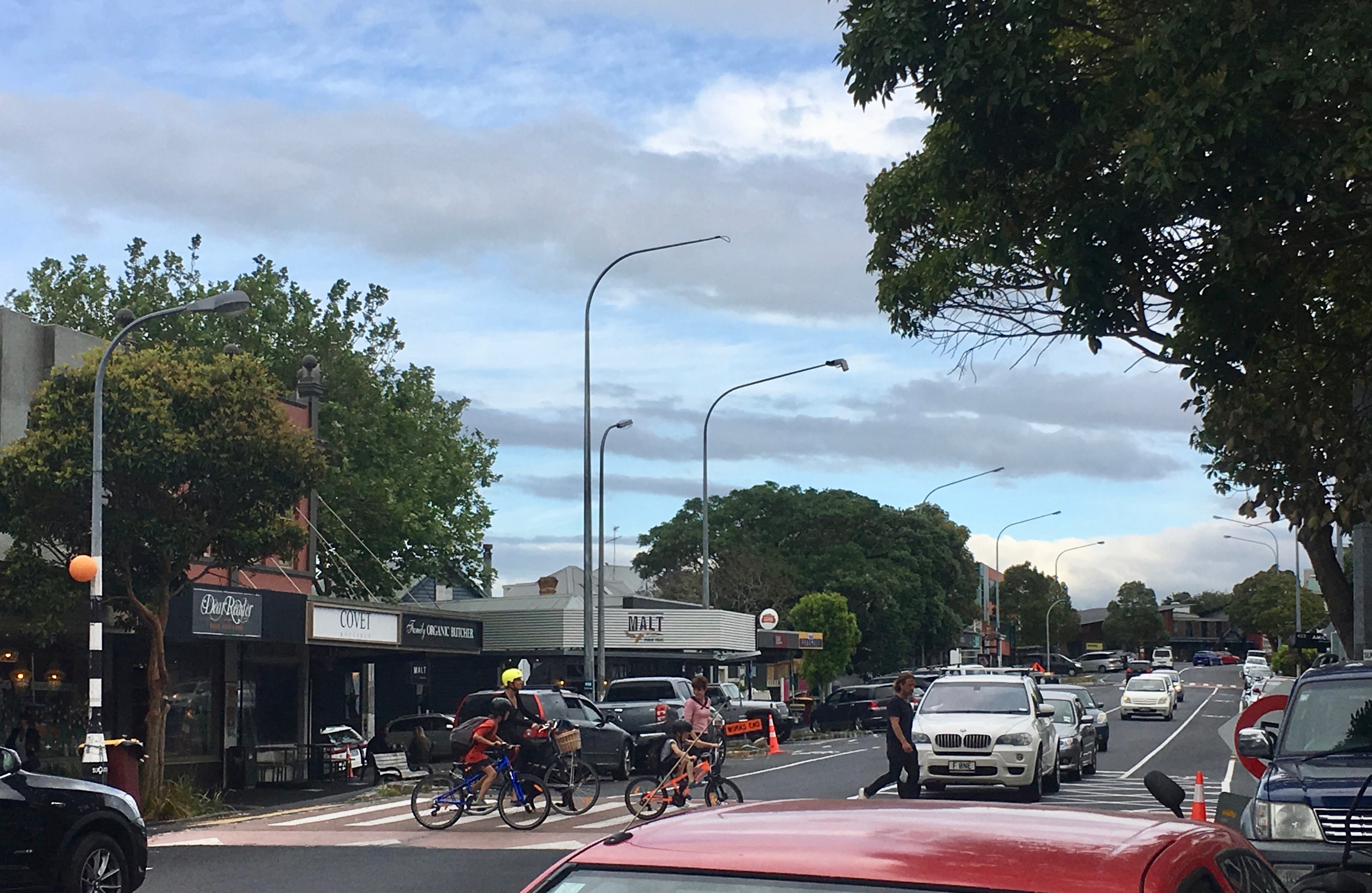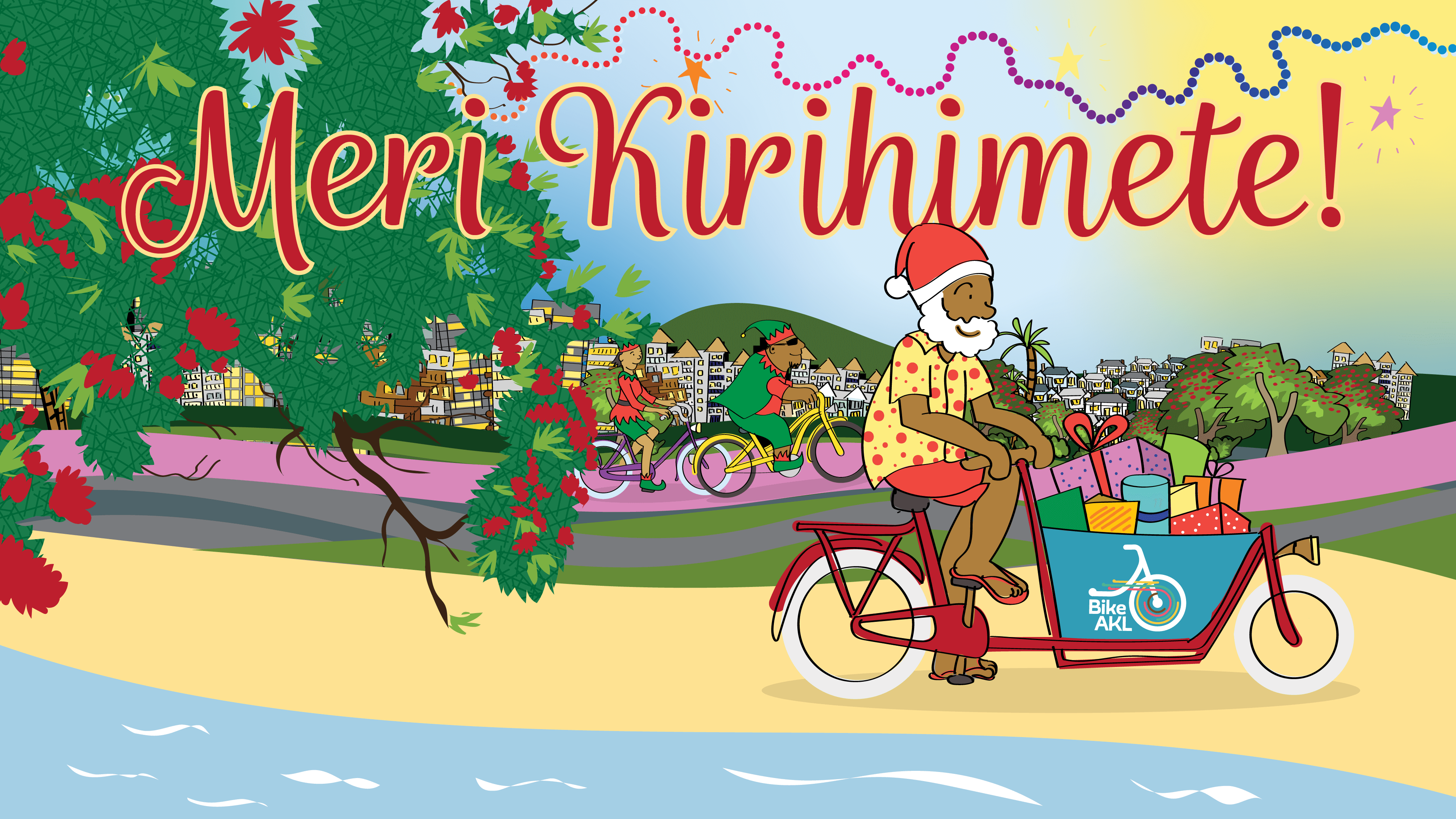Please take a second to support this quick-click petition to ensure that Auckland Transport and the Local Board know there’s heaps of support for livelier, lovelier neighbourhoods – in Grey Lynn and beyond.
Decades from now, we’ll look back on 2017 and say: that’s when it changed. That’s when Auckland reclaimed its urban mojo, stared the data squarely in the face, looked afresh at the vast swathes of tarmac that criss-cross our city… and got back on its bike.
It was the numbers, we’ll say. A sudden rise on the automatic counters along Auckland’s bike paths, well in advance of the usual late summer spike. A ‘network effect’ as newly connected routes pulled riders from far afield. An exponential growth in sales of e-bikes, making hills and distance and age and fitness beside the point.
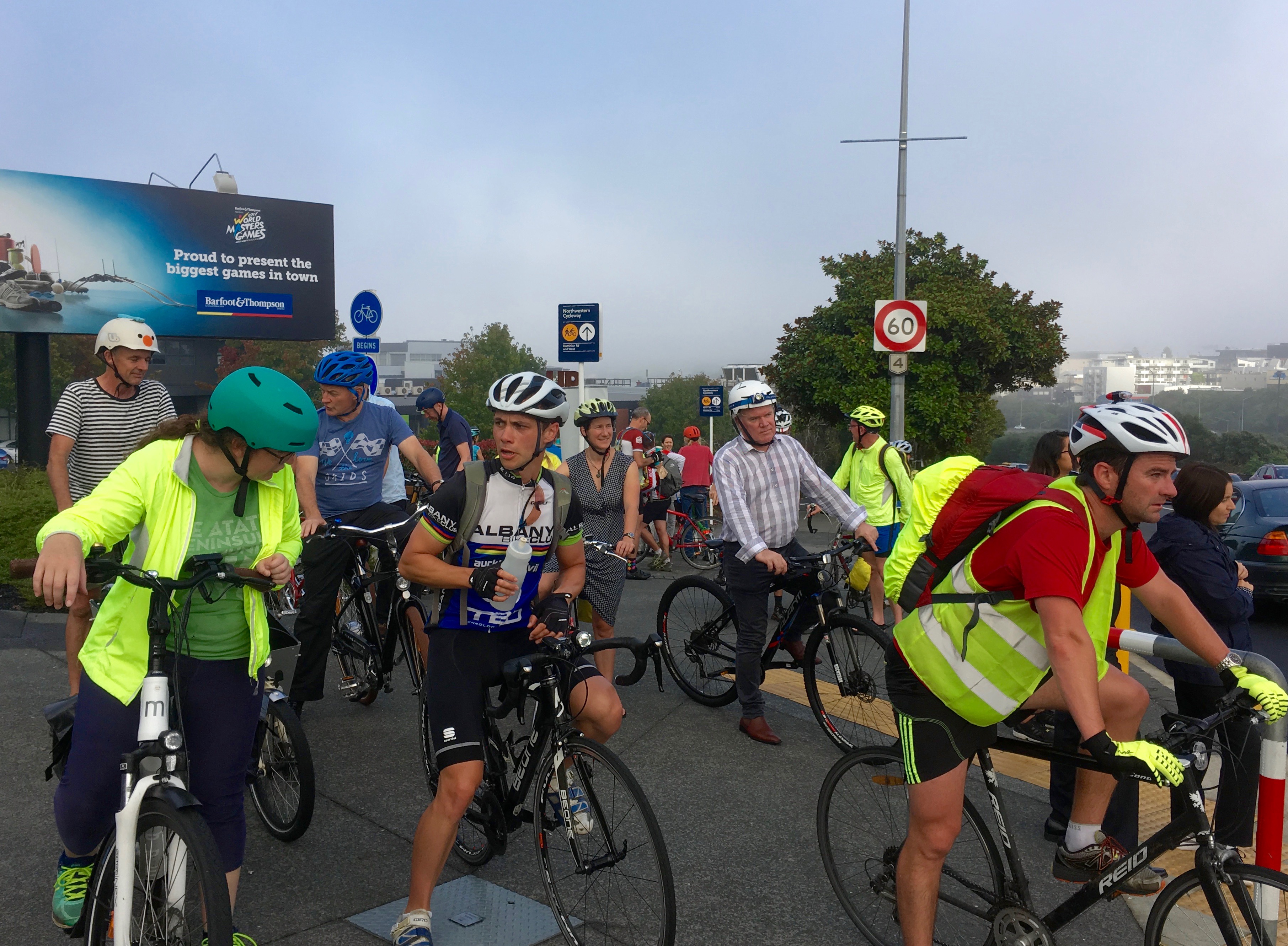
There were other, more sobering numbers. We’ll remember the shocking surge in the road toll that turned our attention to the quality of our transport infrastructure and how it was failing people on bike and foot – in a year when bike casualties more than tripled. And the health statistics that put New Zealand right up there as one of the least active populations in the world; punching above our weight, and not in a good way.
And then there was the climate. The seas around New Zealand, warmer than ever before. Transport emissions starkly revealed as one of the biggest factors in our share of buggering up the atmosphere. There was a shift in the local political weather, and a heating up of the tone of our daily conversations, the vibe in our neighbourhoods, the questions our children were asking us. What to do, an d what not to do?
It was the best of times, it was the worst of times; the times they were a-changing.
We’ll recall the compelling examples set by other cities. London and New York swarmed with wheeled travellers seeking alternatives to cars and subways. Paris threw open its streets to people on weekends, and promised to ban all petrol cars by 2030. Meanwhile, the city of Vancouver casually blazed past its 2020 transport target (50% of city trips by foot, bike, and public transport) six years early. Auckland scrambled to catch up.
We’ll remember 2017 as the year that ‘cyclists’ turned back into ‘people on bikes’. Mums and dads thronging at traffic lights on the way to work. Families spending weekends trying out new bike paths, and discovering the fun of cargo-bikes. Men in suits and school kids having a go on clunky but colourful grab-and-go bikeshare. Young peopel gliding up hills on e-bikes to meet for drinks after work. Retirees taking their bikes on ferries and trains to the fringes of the city for coffee before pedalling back into town.
And we’ll remember 2017 as the year Auckland ventured beyond just threading bike superhighways alongside car superhighways – and started creating all-purpose streets that let us ride and walk safely to school, the shops, or just the dairy on the corner, under our own steam.
Because the real revolution, we will say, happened in our back yards, along our shop fronts, outside of the school gate – and occasionally on our berms. And it looked a bit like this.
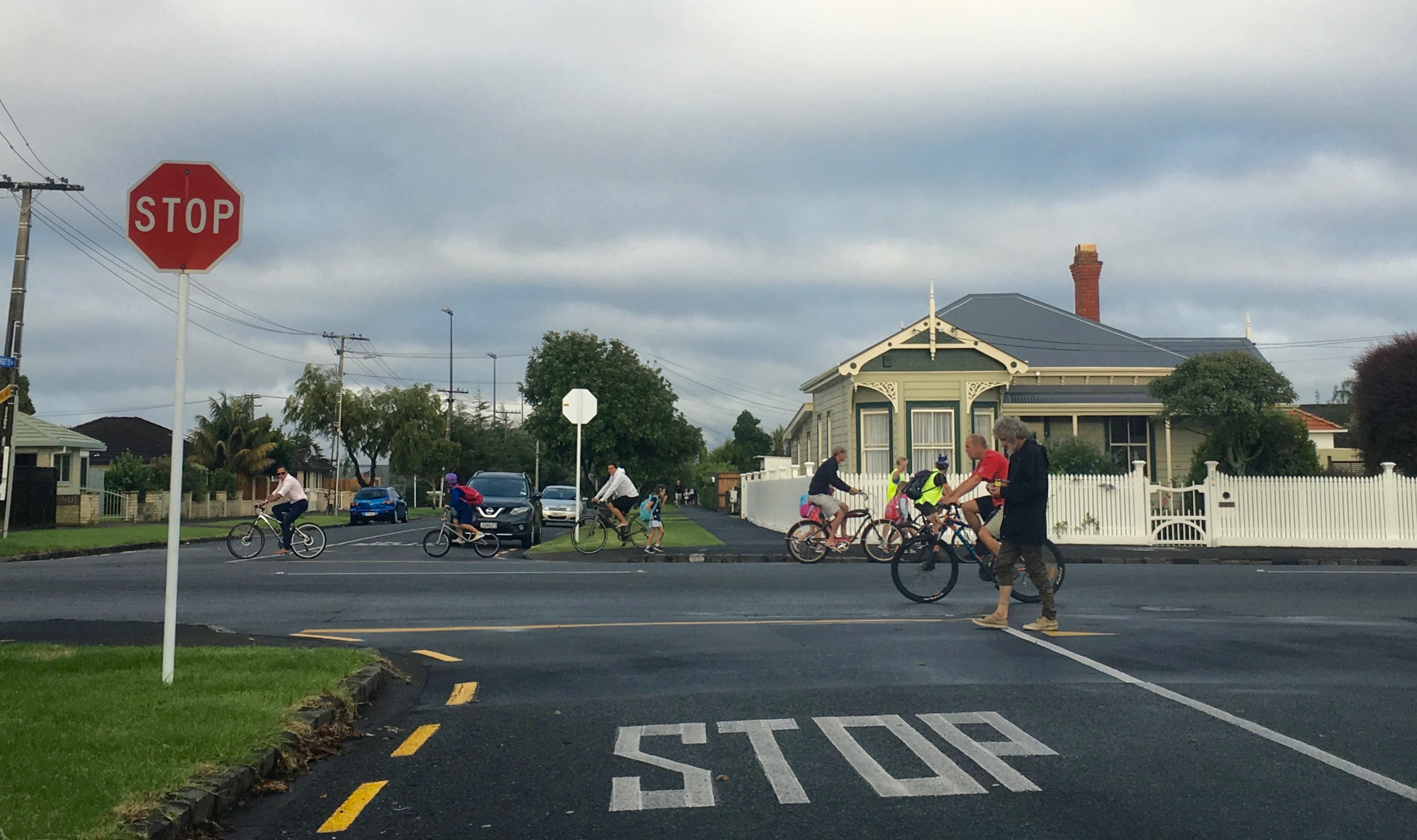
On the ground in Grey Lynn
We’ll also recall the growing pains as the city and its people, together, adjusted to the change in the air. And we’ll remember Grey Lynn – West Lynn – Westmere as a place where Aucklanders worked out how (and why) to do the needful.
By rights, this neighbourhood should have been a shoo-in for ‘bike lanes for the burbs’. A model village, if you like – and what says ‘village’ more than women and kids on bikes? It’s green, greenie and gracious, with a deep memory of diversity and laid-back creativity. True, there are more Remuera tractors (and fewer students and Pasifika families) than a decade or so ago, but it’s still a sweet ‘hood with a great big park at the heart and charming shopping zones.
The bike routes promise a seamless ride past schools and shops, along easily manageable ridge routes, linking locals to each other, to the city, and out to Pt Chev. The routes make sense: after all, there are only so many parks and old motorway off-ramps to build ‘uncontroversial’ cycle paths along.
And people actually want to ride on their local streets to local schools and shops and the awesome new pump track in the park. And it’s so close to the central city cycleway network, and within cooee of the Northwestern and Waterview paths. Join the dots, right?

Well, as covered by Simon Wilson, Russell Brown, and Pippa Coom, the roll-out met a few bumps in the road. There were design difficulties through the shops and a few short-cuts that probably should not have been taken. The local merchants have come to the table to sort things out and appear happy with how things are proceeding.
All going well, the issues will be fixed over the next few months and the project will be completed, to the great satisfaction of those who’ve been yearning for these changes for years, and the perhaps grudging satisfaction of those who aren’t 100% convinced but are happy to see how it goes.
And all not going well? The ‘Battle for the Berm’ on Old Mill Road and Garnet Road – with its local aim of a return to Exactly How Things Were, plus its apparent determination to halt cycleway investment and construction across the city – may bleed into the rest of the city’s plan to become more bike-friendly, distracting from the vastly important discussion on how very much the status quo needs to change.
Because to get where we’re going, Aucklanders are going to have to think about how we plan to live in the 21st century. Are we willing to swap on-road parking spots for better bikeways and footpaths? If so, how many? Do we value those car parks more than grassed berms? Or more than, say, the potential health of a generation of kids?
And who gets to decide for the community? The locals in the immediate vicinity of the change? The shopkeepers? People who’ve lived in a place for decades? People who will live there in future decades? Those who simply want to pass through or visit safely?
Or the many people who just want to ride more bikes on safer streets, who’ve watched the Kiwi tradition of biking to school become almost extinct within a generation? (And it’s fair to say none of us were consulted about that).

The current situation: Auckland Transport, the Local Board and the West Lynn Business Association plus other stakeholders are working in good faith to address the town centre, with a formal community reference group to come. AT and the Local Board will likewise establish a community reference group to re-engage on the second route along Old Mill Road and Garnet Road. (Who’ll be on those groups? That’s not yet clear.)
AT has committed to completing some sections, temporarily finishing up others for safety, and addressing any serious or significant issues identified by a safety audit. It will then review and re-consult on the rest of the route. Also, although construction delays as a result of the protest are reportedly costing the city somewhere around $12,000 a day, it seems AT is committed to putting in the resources to make the final design worth waiting for.
The re-set offers a chance to re-establish mutual confidence among all the people who live in the wider neighbourhood, the people who travel around and through it, and the people whose job it is to maintain and develop its streets and public places. (These are not homogeneous categories, by the way – and nor are they mutually exclusive.)
And as long as everyone goes into the review with respect, integrity, and honesty about what their goal is, it should be fine.
West Lynn is not the beginning of the end. It’s the end of the beginning, as we move – with a lot of noise – into the mainstream of change.
Building a cycleway with both hands tied behind your back
This project will also stand (we hope!) as an example of the last time Auckland Transport attempted to do much with too little.
In an article that – depending on your point of view – either opened the windows and let in fresh air, or turned a chip-pan fire into a raging inferno, Simon Wilson excoriated AT’s ‘extraordinary incompetence’, particularly in delivering the section through the West Lynn shops.
That’s not entirely fair. As covered in the overview by Pippa Coom, Chair of the Waitemata Local Board, there’s a great deal of history and context to the project. It began as long delayed maintenance project to add some traffic calming – while also, in the manner of old-school AT maintenance, putting everything else back the way it was. Then it embraced better bike access, which was at the top of the wishlist in a 2015 Grey Lynn Residents Association survey (along with a swimming pool and a local cinema – now, there’sa model village!).
Along the way, the budget expanded – but as is now clear, by not quite enough.
Which brings us to the street design. The thing is, redesigning road space is a zero-sum game – even on a wide former tram route, there’s a finite area to work with. And every little piece of it is precious to someone. But done well, the results will be far greater than the sum of the parts. Adding bike capacity and public transport improvements to a street brings benefits well beyond the cost, especially in a city that’s become as lopsidedly car-focussed as Auckland.
So what was the difficulty here?
Auckland Transport was boxed in from the beginning. They were trying to add protected bike lanes while removing as little on-street parking as possible, because a few vocal locals are passionately opposed to even small car parking losses.
They were also trying not to touch the painted flush median – that wide strip of land-banked space down the middle of many a road that Aucklanders have come to take for granted. And AT’s experience with upgrading Franklin Road taught them that many locals passionately value the median, even when a local study showed that most normally don’t even pause on it when turning in or out of driveways.
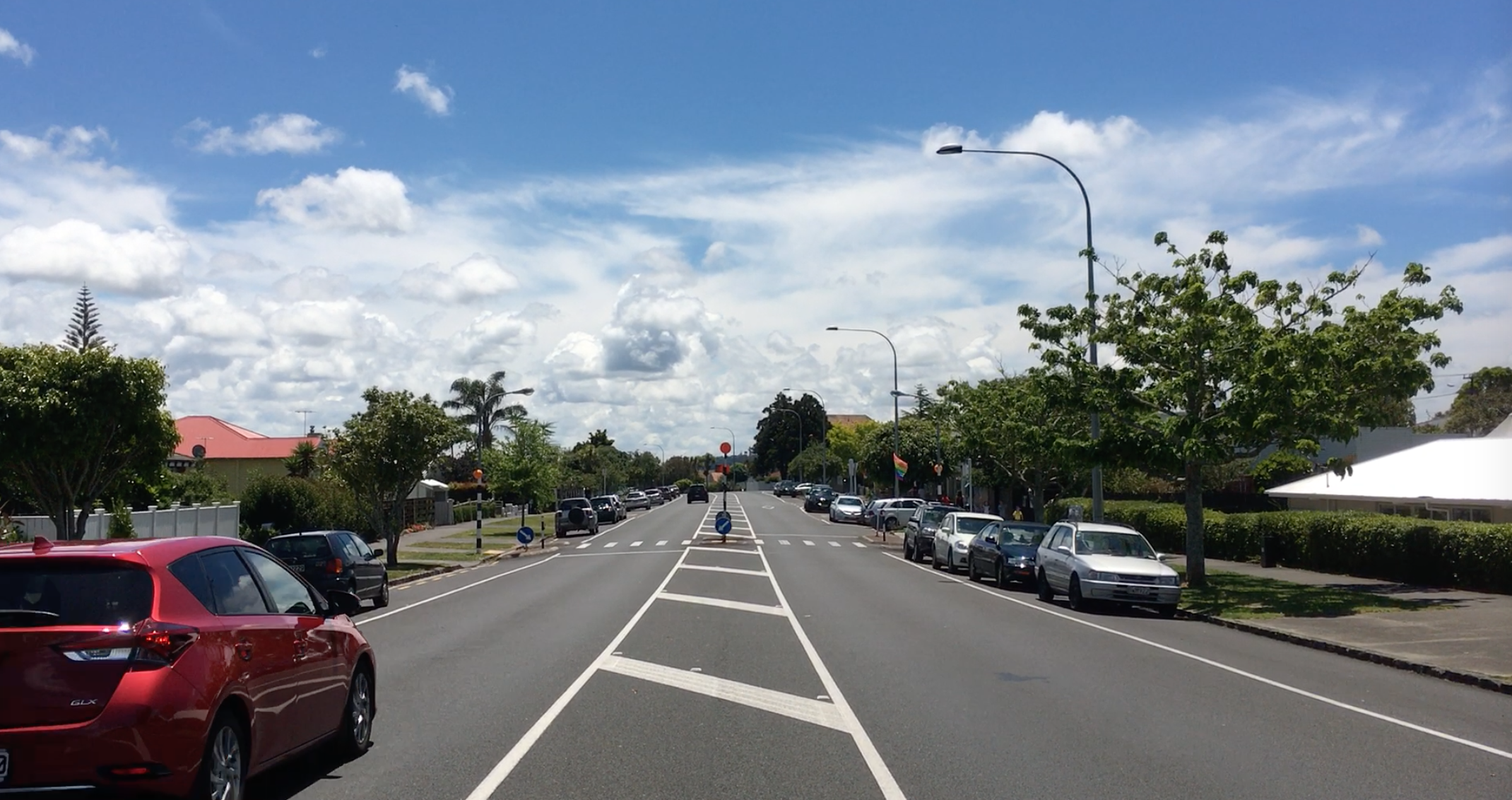
AT was also adding a bikeway, the budget for which had been set before the current infrastructure boom which has seen contractor costs for transport projects rise by between 20% and 50%.
And all this while managing multiple projects with a small, hastily scaled-up bike team (recall, it’s not that long ago that Auckland City Council had a target of “one (1) kilometre a year of new bike lanes”). Inside a wider transport organisation struggling to manage and communicate thousands of projects across a growing city – and with limited resources for better urban design and comms for their bike programme.
It’s a bit like being tasked with cooking dinner, but being told you can’t get the pots dirty or use anything out of the fridge or pantry (and don’t you dare touch the vege garden) – oh, and by the way, the clock is ticking and the children are hungry and the adults are shouting at you that you’re doing it wrong.
So on Surrey Crescent to Garnet Road, the compromise AT finally opted for was a cycleway on the road heading citybound, and the cycleway going the other direction on the berm. This significantly reduced the amount of street parking that would be lost, and the hope was presumably that this would avoid bikelash from locals. Unfortunately, AT didn’t communicate this ‘win’ as well as it could have.

AT also didn’t sense trouble in the fact that the Local Board opposed the berm option as unsatisfactory, even though this early challenge might have provided the impetus to explore alternatives – like using the space from the flush median, or shifting the kerb to create a smidge more road space (which costs more, but may eventually solve the problem entirely).
In retrospect, by accepting the flush median and car parking as untouchable, and opting for the berm and the necessary swerves at intersections, Auckland Transport unfortunately opened themselves up to attack on a new front – that they were covering greenspace with ugly asphalt. In practice, most existing trees were preserved and worked around, and many more in total were planted than were lost or moved (not that the facts got in the way of fanciful claims about ‘all the mature trees’ being removed along Surrey Crescent.)

So the protest narrative shifted from objecting to loss of carparks outside a cafe and in the shopping precinct redesign, to defending the green heart of Grey Lynn (well, its grassy berms) against a heartless bureaucratic machine. Lost in the noise were some crucial larger stories: the value of car parks versus children on their bikes; the growing demand across the city for safe, connected bike routes; the rising global temperatures.
The irony, it burned: halting a bike project under a green banner, in effect to preserve parking? Never mind that stopping progress on bike-friendly streets and going back to our cars as before is the antithesis of sustainability. Never mind that the bike paths only detoured onto the berms because of a determination to save spaces to store cars (and that residents continued to park on the berms anyhow).
Never mind that there’s a much larger community out there that wants safe bike travel.
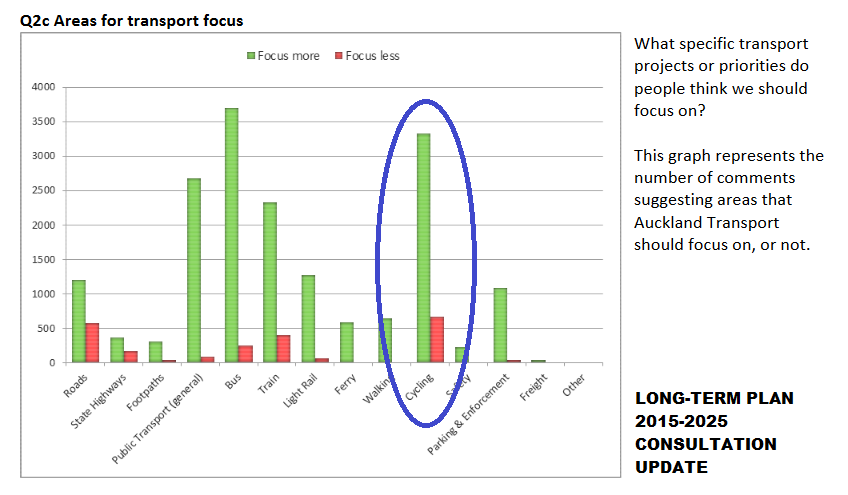
Reminding ourselves where we’re heading
First off, this is about how we want to live, what we want our city to look like, and who gets to choose directions for our collective future.
For example, there are some 4,000 children at various schools along the routes up for construction from town to Point Chev. They’ll live with the results of this project a lot longer than the rest of us will. They’re already living with the results of decades of neglect and inaction. And we live with driving them to school, when they’d love some independence and we’d love the confidence that they’ll be safe, out on their own.
It should also be acknowledged by everyone involved that making it safer for more people to walk or bike for short local trips rather than jumping in the car will make a sizeable dent in our transport emissions, which is something Auckland Council and Auckland Transport and the government have a mandate to do.
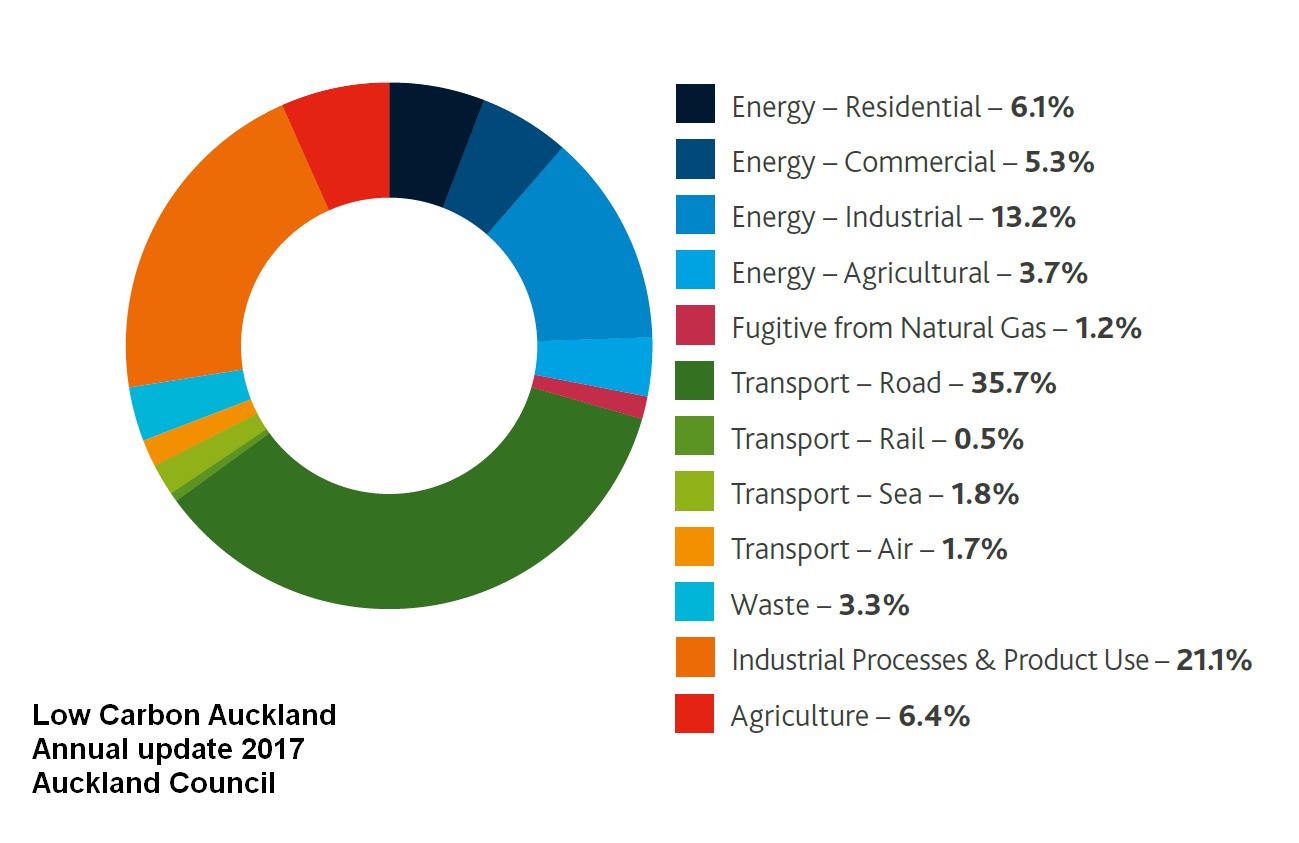
Some numbers may help here. Say the new safe bike lanes are attractive enough to take just 100km of daily driving out of the picture. That’s, say, 100 trips to the dairy and back. Or 50 school runs. Or ten commutes to town and home again. Not much, really. Piddling numbers compared to, say, the 800 trips a day on the Northwestern Cycleway (which is growing by 20% a year), or the 400 bike trips a day up and down Pt Chevalier Rd in its current embryonic state.
So, say a car-travel reduction of 100km per day was all you achieved. After a year of that level of modest local bike use, you’d have removed 5 tonnes of carbon from the picture, the equivalent of planting 2 hectares of forest. Persuade twice as many people to give it a go, and there’s 4 hectares of forest.
A neighbourhood could get to feeling quietly proud of that little carbon contribution.
You’d also be getting more people moving, into the bargain – making it less likely that your kids, say, will fall victim to Type 2 diabetes. Patrick Morgan of CAN notes that it costs roughly the same to outfit a school with a Bikes in Schools fleet and bike training – which gets 200 kids on bikes within a week – as it does to fund a year of dialysis for a person with advanced diabetes. The point is not either/or; the point is, smart investment in the former will help us all avoid an epidemic of the latter. Local trips add up, healthwise.
As well as creating a lively hood, you’re improving the livelihoods of local shopkeepers. For every bike that you send through a local town centre, you increase the chance that the person on it will stop at a local dairy, shop, or cafe. The data is clear and repeated worldwide in study after study – bike riders overall spend much more money locally than people arriving by car, because they visit more often. Car parks are an interminable game of musical chairs, and there will never be enough to compete with the malls. Whereas, bikeways done right are retail boosters that keep our town centres thriving.
Even better: the same thing that makes people on bikes stop at their favourite shop (because they never need to circle the block for a car park!) also makes it so much easier to stop and chat to your mates or neighbours. Or take a moment to pat a nice doggo out for walkies. We’ve all become a bit more shut-in during the last decades of modern life, even before social media. Getting out and about without wrapping ourselves in our convenient metal boxes creates more of those little chance encounters with others that make a real community.
Because that’s the ultimate prize: a village that feels like a village; a community that feels like a community. Here’s the thing: the rewards of a more bike-friendly place are immense for those who’d like to bike; they’re even greater for those who may never bike.
Where to from here, by car or bike?
So how do we get there, after the current heated rhetoric burns itself out, and we re-set and re-start?
Some things are obvious. We get urban designers involved to help the traffic engineers. We work harder on telling the story of why we are making these changes – and for whom. We listen to the concerns, and try to deal with them fairly.
And we make space for voices that haven’t been heard at top volume yet.
Because when one set of voices dominates the conversation, it’s easy to think they have the strongest feelings about the issue. For example, an early headline described how upset some local merchants were over the moving of parking spaces and bus stops, and it’s fair to say subsequent meetings have so far been dominated by a handful of furious voices in defence of ‘how it always was.’
Anger is a legitimate feeling. Other people are feeling it too – anger at the lives of people on bikes being ranked lower than a few seconds less delay for drivers or a few extra car parks; anger and deep sadness that children may finish school before it’s safe for them to walk or bike there independently; desolation that the latest communications from the planet aren’t jolting us into positive action for more sustainable travel options.
Really, truly hearing and acknowledging the full range of feelings about reshaping our city – especially the currently quiet voices – in a positive, civil, collaborative context, will help create a more equitable and respectful outcome for everyone.
As we make space for those voices, we also need to quash some of the sillier suggestions floating around, like the one that people on bikes should avoid the main streets and travel along quiet back streets and waterways, like burglars or pukeko.
Not only are the schools and shops on the main roads, but like drivers and walkers, people on bikes want to get from A to B. It’s about access – not either/or, but both/and. Safe routes on main streets, and effective slow-speed traffic-calming on the side streets, to get you all the way to your front gate and keep your pets alive, too.
It will also be crucial to address spurious ‘safety’ arguments head-on, with data and evidence. So far, a range of familiar concern-trolling arguments are getting a fair amount of play: that an on-road cycleway is ‘dangerous’ (because cars might cross it), that parking protected cycleways are dangerous (because cars will cross them), that a berm cycleway is dangerous (because cars might cross it) and that people should just ride on the road (between moving cars and the door-opening zone of parked cars). And of course, that there aren’t any people on bikes anyway (because… cars). Underpinned by the old classic: we’ll never be the Netherlands, given how special New Zealand are (because… driveways).
AT’s own design guidelines recommend protected cycleways on 50 kph speed roads where traffic flows are more than 5,000 a day. Garnet Rd and its intersections may feel to some like a ‘soft ballet of cars, moving beautifully’ as one protester put it, looking for something worthy to preserve (in amber?) in all that day-long hurtling back and forth. But Garnet Rd sees solid day-long busy traffic, far above the level recommended for riding on the road. A recent count on 1 September 2017 recorded 8,826 cars, often going at a pretty fast clip.
Riders young and old deserve better options other than huddling along the edge of that traffic, or taking to the footpath as a literal ‘life hack.’
Luckily, we can achieve a lot of things when we decide to put more resources into this. Making the design not only functional for everyone, but also beautiful, should be a priority. While cheap and cheerful can work for quick fixes, nobody wants yellow plastic posts cluttering up our town centres permanently. With transport changes that stay around for decades, like kerbs and berms, quality should be the goal. And everyone loves trees – we can certainly agree on that.
Along the way, we’ll need to have some serious chats and work through some questions about priorities when redesigning the street cross-section. Compromises will be a natural part of the process; but let’s make sure that the design itself is not a compromised one.
Because sometimes, not even more resources and more money and more urban design will entirely square the circle or soothe the more decided opponents. Against the familiar cry of ‘put it back how it was, because that’s always worked for us’, we’ll need the voices of those it doesn’t work for, and those who will live with the results the longest – our children.
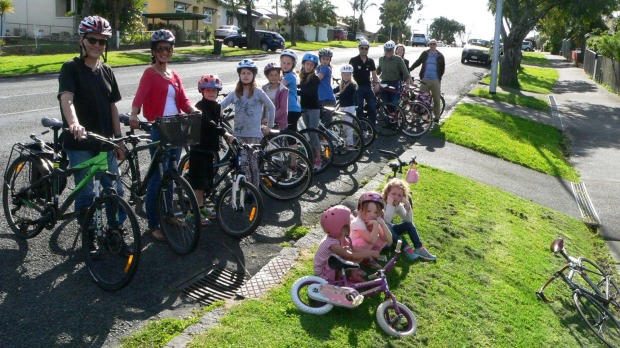
Above all, let’s keep our eyes on the prize: because getting more of us out walking and cycling on green streets offers bountiful good news stories of the kind our stressed-out world needs right now – just as long as we give our communities the chance to tell them.
Auckland gets so excited about big ideas and dramatic results – Lightpath, for example, and the prospect of Skypath. The real courage will be in giving the same opportunity to our children, and to ourselves, in our neighbourhoods around the corner. When biking to the dairy is as normal and as valued as biking over the bridge, we’ll know we’re there.
Please take a second to support this quick-click petition to ensure that Auckland Transport and the Local Board know there’s heaps of support for livelier, lovelier neighbourhoods – in Grey Lynn and beyond!

